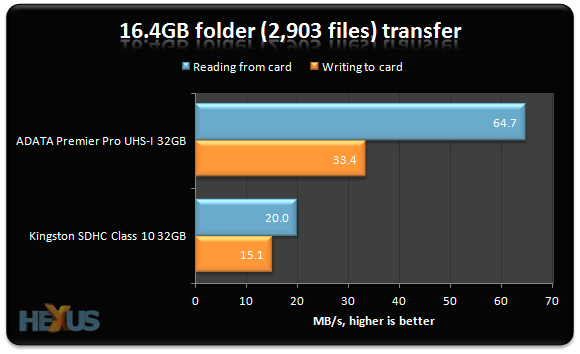The numbers and thoughts

Pushing the SDHC cards in a different manner, this test involves moving our Batman: Arkham City folder to-and-from the cards. The host drive, containing the operating system, is a Corsair V128 SSD. The Batman folder contains over 1,000 files that are sub-100KB in size. Granted, this isn't an everyday test for an SDHC card but does provide insight into the quality of the flash memory. ADATA, as expected, produces excellent numbers.
These transfer benchmarks illustrate that ADATA's speed claims for the Premier Pro SDHC card are more-or-less borne out. Question is, what does this really mean to the consumer? High-quality digital cameras and camcorders use advanced file-compression technologies - H.264 or AVCHD, for example - to minimise the speed and capacity required when storing video. An SDHC Class 10's 10MB/s (80Mbit/s) writing speed is more than sufficient for most prosumer video recorders, then.
One real-world test that we can think of which may show a performance delta between a Class 10 and UHS-I SDHC card revolves around calculating how long it takes for a digital SLR camera to clear its memory buffer and allow the removal of the card when shooting in frenetic burst mode. The faster the buffer's content can be written out to the card, the shorter the wait until it can be removed.

We used a Nikon D3100 and Canon EOS 600D, two mainstream, well-reviewed dSLR cameras, for the buffer tests. Each camera's file format was set to RAW+L/F JPEG - it provides the largest files - and kept shooting in burst mode until the camera slowed down, intimating that the buffer was full. We then hand-timed the duration until the activity/buffer light went out, such that the card could be safely removed.
The Nikon D3100 doesn't support the UHS-I interface, as far as we can discern, and so the buffer-lit times are nigh-on identical between the two cards; the difference may well be the standard deviation in timing on our part. The Canon EOS 600D, meanwhile, does support the UHS-I format but shows little improvement in the time taken to clear the buffer. Our best guess is that it doesn't properly support in the interface speed, falling back to Class 10 bandwidth.
Looking into the area further, most pro-level cameras only provide basic format-recognition support for UHS-I, insofar as they default back to Class 10 speeds. The Canon EOS 5D Mark III, for example, costing over £2,000 for the body alone, records much faster on to a CompactFlash card.
Final thoughts
ADATA's Premier Pro UHS-I-compliant SDHC 32GB card is the fastest we've ever seen. Bandwidth benchmarks highlight that it can be up to 4x faster than a quality Class 10 card of the same capacity. The electric speed is an impressive demonstration of how far these postage stamp-sized cards have come in recent months and years, though we remain unconvinced of their mass-market appeal. Most SDHC-orientated devices such as digital SLRs and camcorders work perfectly fine with a Class 10 card, which is one-quarter the price, and pro-level kit tends to favour high-speed CompactFlash instead of UHS-I-based SDHC.
The speedy nature of the Premier Pro is best-realised in instances where the entire capacity is being transferred to a PC on a regular basis, getting it ready for some Photoshop lovin'. One can transfer the full 32GB capacity in around eight minutes when allied to a decent USB 3.0 card reader and fast host drive; compare this to over 25 minutes for the Kingston Class10 SDHC card.
Right now, we believe the ADATA Premier Pro SDHC 32GB card's high street price precludes it from being recommended to the masses. But if you're deep of pocket and short on patience then there's little faster in this particular card format.
The Good
Blisteringly fast for an SDHC card
The Bad
4x the price of a Class 10 card
Most pro-level dSLRs run better with a fast CF card
HEXUS Rating

ADATA Premier Pro UHS-I U1 SDHC 32GB
HEXUS Awards

ADATA Premier Pro UHS-I U1 SDHC 32GB card
HEXUS Where2Buy
TBC.
HEXUS Right2Reply
At HEXUS, we invite the companies whose products we test to comment on our articles. If any company representatives for the products reviewed choose to respond, we'll publish their commentary here verbatim.













